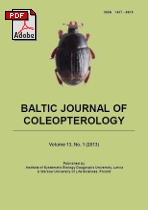Carabid beetle (Coleoptera: Carabidae) diversity in agricultural and post-agricultural areas in relation to the surrounding habitats
Main Article Content
Keywords
:
Carabidae, MIB, agriculture, fallow, landscape, species diversity, management, succession
Abstract
<p>Carabid beetles were studied in eight study sites, representing differently treated agricultural and post-agricultural areas and their surrounding habitats. The study aimed to answer the questions (1) to what degree differently treated agricultural and post-agricultural areas differ with respect to stage of succession, species numbers and species composition, and (2) what is the impact of the different measures on the species diversity across a larger area (landscape).</p><p>Altogether, 933 individuals from 61 species were collected. The study sites differed with respect to the successional stages. Species numbers ranged from 8 to 25 species. High ß-diversity values did not always correspond with low Jaccard indices for the respective pairs of study sites. Special attention has to be drawn particularly to species, which are rare in the studied landscape, and to the respective habitats. A correspondence Analysis (CA) indicated that human management impact seems to be of special importance with respect to differentiation of the carabid coenoses.</p><p>The study indicates that the value of a single site with respect to biological diversity has to be assessed in the context of a larger area, in which it is embedded (landscape). It is necessary to identify those types of landscape elements, which are missing to exploit the full potential of the landscape. In this context not only the individual landscape elements but also the landscape structure is of importance.</p>
Article Details
Statistics
Downloads
Download data is not yet available.
Recommend Articles
